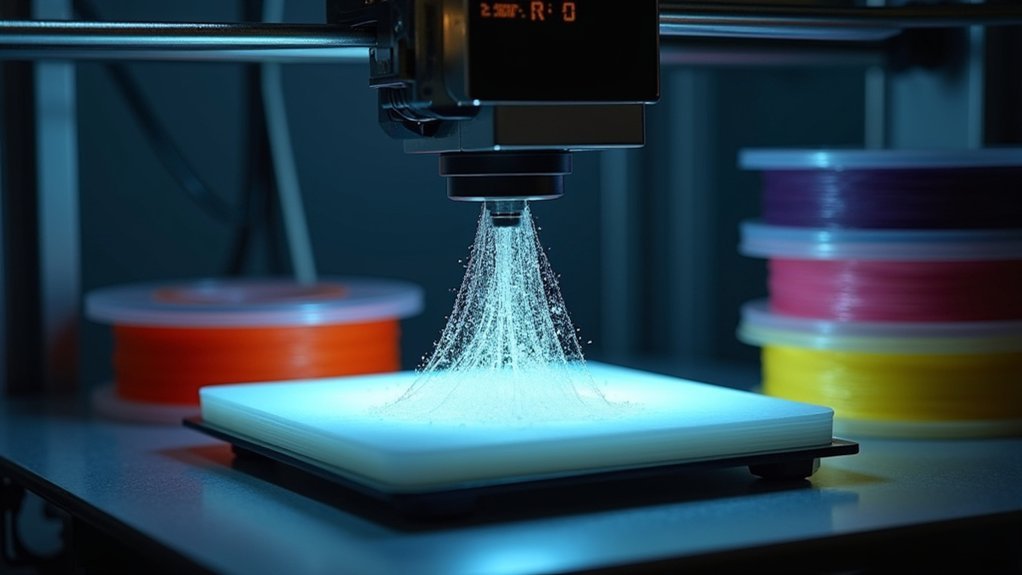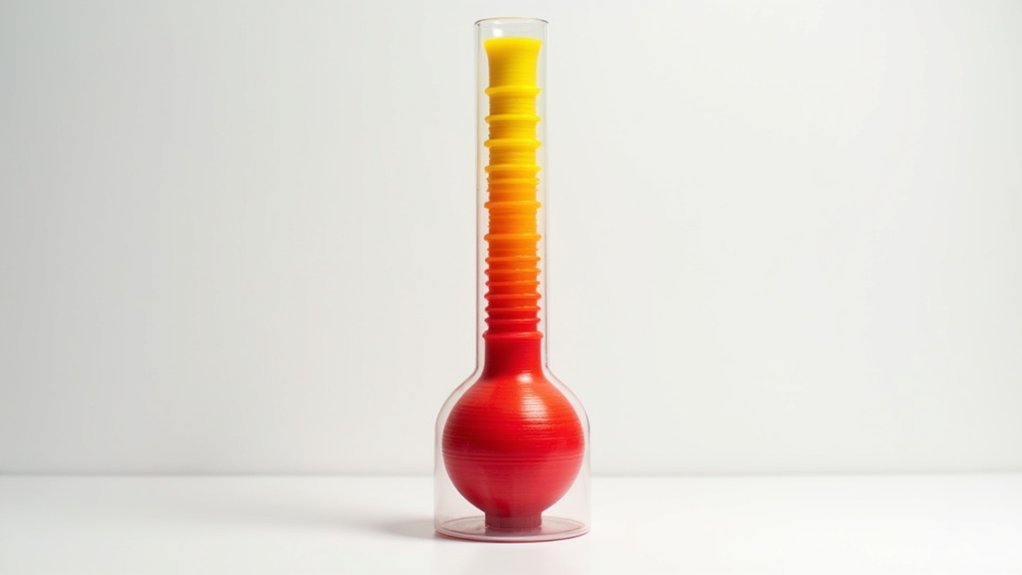You can eliminate 3D printer stringing by implementing three temperature-focused solutions. First, lower your print temperature by 5-10 degrees Celsius to increase filament viscosity and reduce oozing during travel moves. Second, find your material’s ideal temperature range through systematic testing—PLA works best at 190-220°C while PETG performs best around 225°C. Third, use temperature towers with 5-degree increments to precisely calibrate and identify the perfect temperature that minimizes stringing while maintaining print quality and layer adhesion for your specific setup.
Lower Print Temperature to Reduce Filament Oozing

When filament oozes from your nozzle during non-printing movements, it creates those annoying strings that mar your print’s surface quality.
You can combat filament oozing by implementing a simple yet effective strategy: lower print temperature by 5-10 degrees Celsius. This adjustment increases filament viscosity, reducing unwanted oozing during travel moves.
Each material has a suitable temperature range—PETG typically performs best around 225°C. You’ll need to stay within these boundaries while reducing stringing.
Finding the optimal temperature within your material’s range is crucial for eliminating stringing while maintaining print integrity.
Temperature tower tests help you identify the perfect temperature for your specific filament, allowing you to observe filament behavior at various settings.
Monitor how your material responds during printing at different temperatures. This approach to reducing stringing maintains excellent print quality while minimizing those frustrating strings that compromise your finished models.
Find the Optimal Temperature Range for Your Material
Finding your material’s sweet spot requires systematic testing rather than guesswork.
You’ll achieve the best results by conducting temperature tower tests to identify where your specific filament exhibits minimal stringing and ideal layer adhesion. PLA typically performs well between 190-220°C, while PETG usually requires 220-250°C for ideal results.
Each brand and color can behave differently due to formulation variations, so you can’t rely solely on general guidelines.
Monitor your filament behavior carefully during testing – high viscosity from excessive nozzle temperature increases oozing and stringing. Conversely, temperatures too low cause under-extrusion issues.
Start within your material’s recommended ideal temperature range, then fine-tune based on actual performance. This methodical approach guarantees you’ll find the precise temperature that eliminates stringing while maintaining print quality.
Use Temperature Towers for Precise Calibration

Temperature towers eliminate the guesswork by printing multiple test sections at different temperatures in a single job.
You’ll create a tower with 5-degree increments, allowing precise calibration for your specific filament. Each section reveals how temperature affects stringing, oozing, and overall print quality at your nozzle.
Configure your slicer to automatically adjust temperature during the print, ensuring seamless changes between sections.
Monitor each level for defects like excessive stringing or poor adhesion. The ideal temperature range becomes visually apparent when you examine the finished tower.
This method dramatically reduces trial-and-error time compared to printing separate test pieces.
You’ll identify the sweet spot where your material flows properly without creating strings, improving retraction effectiveness and eliminating oozing between moves.
Frequently Asked Questions
How Do I Stop My 3D Printer From Being Stringy?
You’ll reduce stringing by lowering your print temperature 5-10 degrees, running temperature tower tests, and drying moisture from your filament. Monitor for popping sounds that indicate wet material.
How Do You Lower the Temperature to Reduce Stringing?
You’ll reduce stringing by lowering your nozzle temperature 5-10 degrees in your slicer’s settings. Access “Edit Process Settings,” adjust the temperature, and run a temperature tower test to find your filament’s ideal range.
Why Do My 3D Prints Keep Coming Out Stringy?
Your 3D prints turn stringy because you’re printing at too high temperatures, causing filament to ooze from the nozzle during travel moves, or you’re using poor-quality, wet filament.
How Do I Fix the Heat Creep on My 3D Printer?
Check your cooling fans are working properly and clean any debris from the heat break. Verify adequate airflow around the thermal barrier and consider upgrading to a better heat break with active cooling.





Leave a Reply